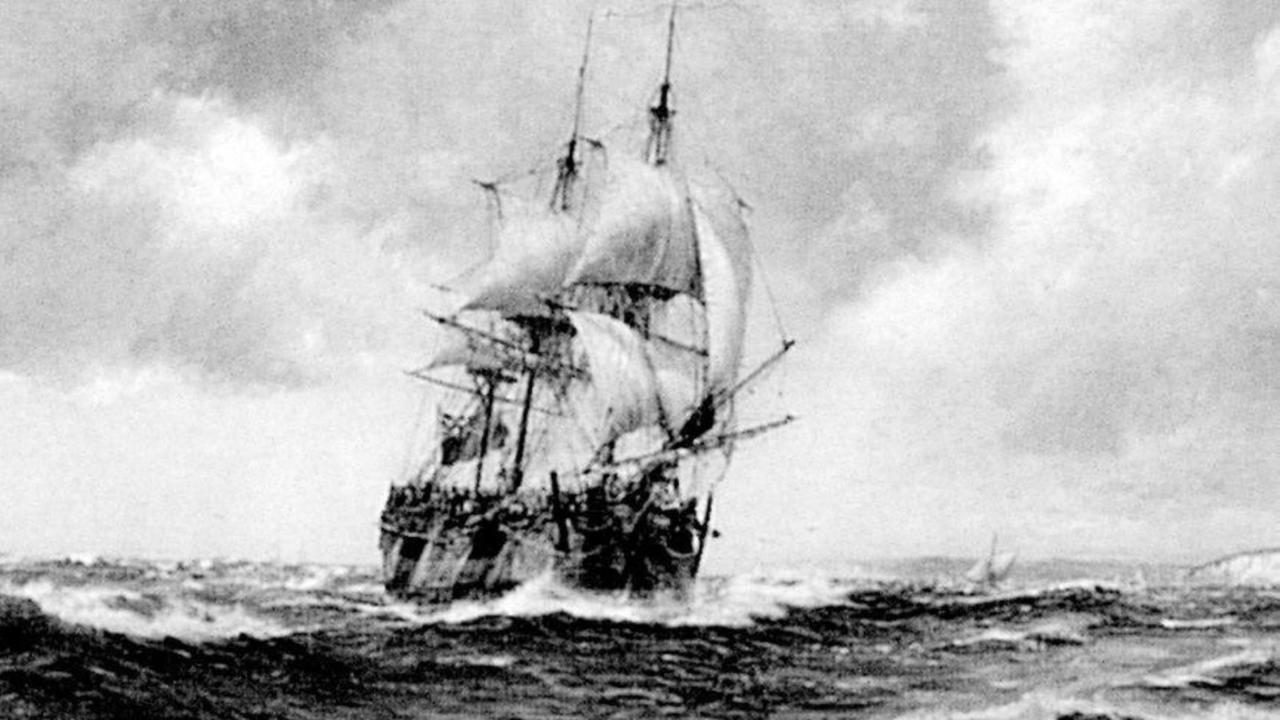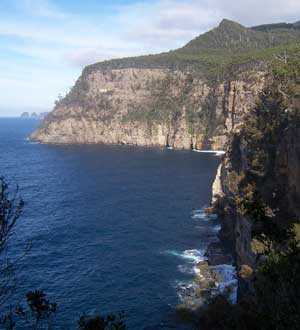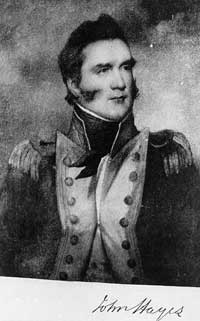

Waterfall Bay, named by Hayes
 Lieutenant John Hayes, on an exploring expedition to Van Diemen's Land for the British East India Company, explored the d'Entrecastreaux Channel and the River Derwent between April and June 1793. Hayes in command of the vessels the "Duke of Clarence" and the "Duchess of Bengal", landed at Oyster Cove and apparently got on quite well with the local tribe of natives. Hayes explored the lower reaches of the Derwent, as far up river as New Norfolk. Impressed with Risdon Cove, he named it after William Bellamy Risdon, second officer of the ship "Duke of Clarence".
Lieutenant John Hayes, on an exploring expedition to Van Diemen's Land for the British East India Company, explored the d'Entrecastreaux Channel and the River Derwent between April and June 1793. Hayes in command of the vessels the "Duke of Clarence" and the "Duchess of Bengal", landed at Oyster Cove and apparently got on quite well with the local tribe of natives. Hayes explored the lower reaches of the Derwent, as far up river as New Norfolk. Impressed with Risdon Cove, he named it after William Bellamy Risdon, second officer of the ship "Duke of Clarence".
Lieutenant John Hayes, named geological features that still retain the names today, being Risdon Cove, Cornelian Bay and Mount Direction. He also named Clarence Plains after one of his ships the "Duke of Clarence". Clarence Plains is today known as Rokeby.
Hayes was unaware he was not the actual discoverer of the River Derwent. He later learned that French explorer Admiral Bruni d'Entrecasteaux had discovered the river shortly before him in February, while searching for the lost La Perouse expedition. Bruni d'Entrecasteux named the river "Riviere du Nord" (as the river flowed from the north).
John Hayes, named the River Derwent after the geographical features of Derwentwater and the Derwent River, in the Lakes District of his native Cumberland in England.
Maatsuyker Islands
25.11.1642The Maatsuyker Islands as a group were named by Abel Tasman on 25.11.1642 after Joan Maetsuijker, a member of the Council of Batavia who had sponsored the expeditions of its discoverer. The islands were individually named by Commander John Hayes, and collectively as The Three Brothers. The Aboriginal name for the islands is Draywanee.
The Sisters
Hayes. A pair of islands similar to the Maatsuyker Islands.
Simpsons Point
1793. Hayes.
Fluted Cape
14.3.1773. Hayes. Its shape. Named Cap Cannele by D'Entrecasteaux, 6.5.1792.
Betsey Island
1793, Hayes. Previously named Willaunez Island by D'Entrecasteaux a few months earlier after one of his officers. Renamed Franklin Island after Lady Franklin bought it. The island reverted to its original name after her death.
Trumpeter Pt / Trumpeter Bay
1793. Hayes.
The Yellow Bluff
1793. Hayes.
One Tree Pt
1793. Hayes.
Garden Isld
1793. Hayes.
Oyster Pt
1793. Hayes. Oysters found in abundance here.
North West Bay
1793. Hayes. Descrptive of its location.
Crayfish Pt
1793. Hayes. Many crayfish caught here.
Gellibrand Pt
1793. Hayes. Named after Joseph Tice Gellibrand, a lawyer, was a member of the Port Phillip Association which crossed from Tasmania to Victoria and took possession of the land around Melbourne and Geelong under a treaty with the native chiefs. Gellibrand prepared the treaty documents. With G. B. L. Hesse, a fellow solicitor. He disappeared in 1837 on an exploratory expedition around the Colac area on a journey from Geelong to Melbourne via the Barwon Ri ver. Williamstown was originalkly known as Port Gellibrand.
Derwent River
1793. Hayes. Named after the geographical features of Derwentwater and the Derwent River, in the Lakes District of his native Cumberland in England. Three months earlier, d'Entrecasteaux had returned to the area to repair his ships on his return home to France and named it "Riviere du Nord" (as the river flowed from the north). The river estuary was then named Port Buache by Baudin, 4.2.1802, after Philippe Buache (1700-1773), French geographer.
Courts Bay / Island
1793. Hayes. Named after Thomas William Court, 1st Officer of one of Hayes' ships, 'Duke of Clarence'.
Risdon Cove
1793. Hayes. Named after William Bellamy Risdon, second officer of one of Hayes' ships, 'Duke of Clarence'.
Cornelian Bay
1793. Hayes.
Ralphs Bay
1793. Hayes. Named Double Bay by D'Entrecasteaux, 6.5.1792.
South Arm
1793. Hayes. Descriptive.
Pitt Water
1793. Hayes. Recalls British Prime Minister, William Pitt the Younger.
Tiger Head
1793. Hayes.
Carlton Bluff
1793. Hayes.
King George Isld
1793. Hayes. Named after the reigning monarch, King George III.
Whitehouse Pt
1793. Hayes.
Sloping Isld / Sloping Main
1793. Hayes. Its orientation.
North West Head
Named Cape Connella by D'Entrecasteaux, 8.5.1792 after a seaman, Recherche, who first sighted the cape.
Outer North Head
Descriptive.
Waterfall Bay
Hayes. Descriptive, as a number of waterfalls flow down its sheer cliffs into the ocean. Named Monge Bay by Baudin, 17.2.1802, after Gaspar Comte de Peluse Monge (1746-1818), French mathematician.
Blackman Bay
1793. Hayes. Tasman named it Frederick Henry Bay, 6.12.1642, after Dutch Prince Frederick Henrijk whose flad he planted on its shores. In 1773 when he visited the area, Furneaux mistook Blackman Bay for Frederick Henry Bay. Furneaux's charts were used to prepare the Admiralty charts of today, which is why the name still applies to the wrong bay. It was at Blackman Bay on 3rd December 1642 that Tasman's ship's carpenter, Peter Jacobsen, volunteered to swim ashore with a pole on which was the Prince's flag, which he planted on the shore of the bay. In doing so, Tasman had taken possession of Van Diemen's Land for the Dutch.